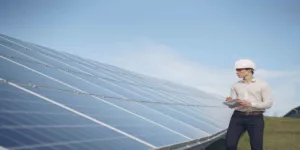It’s never a bad thing to try to lower your utility costs, and with the green energy revolution, there are more ways to save than ever before. Programs that fall under the general category of net metering can help individuals save money on their electric bills, and even earn money on the excess energy produced, depending on the type of installation and the property owner’s specific situation.
One of the best ways for municipalities, nonprofits, and other qualified organizations to dramatically reduce energy bills is through virtual (or “remote”) net metering agreements, like those offered by Green Development, LLC.
Home and business owners who install solar panels on their roofs can take advantage of standard net metering agreements enabling them to get credit for excess power production, according to the rates paid by the local utility.
What Is Net Metering?
In order to define net metering, it’s important to understand how wind and solar energy are generated and stored. Both wind turbines and solar panels rely on the right weather conditions to generate power. Turbines don’t work as efficiently when the wind is calm, while solar panels require sunshine.
The energy that turbines and solar panels produce is either consumed onsite, stored onsite, or sent into the grid; it’s at this point that net metering comes into play.

Types of Net Metering
Broadly speaking, there are three ways to use this renewable energy:
Behind the Meter Solar or Wind
For home or business owners who install solar panels or wind turbines, there is an option to consume and store all of the power they create. This is referred to as “behind the meter” solar or wind because all of the energy is generated onsite.
Net Metering
In areas in which net metering is more attractive than investing in lithium battery storage from a financial perspective, home and business owners may decide to send excess solar or wind energy to the grid. The meter then tracks your energy usage and compares that amount against what you contributed to the grid. If you consumed more than you produced, you’d simply pay for that excess usage. If you have used less, you’ll receive either a payment or a credit towards a later bill.
Virtual or Remote Net Metering (VNM or RNM)
Unlike standard net metering, which requires that the equipment be onsite, VNM enables participants to save on energy costs by committing to a share of the production of a renewable energy installation. This can be a neighborhood solar array, a remote solar site designated as a community solar project, a wind turbine farm, or a variety of other projects.
Laws regarding VNMs differ from state to state. In Rhode Island, for instance, the VNM program is separate from the community solar program. The latter is available to all Rhode Island homeowners; VNM, on the other hand, is available only to nonprofits such as the YMCA, colleges, and hospitals, municipalities, and quasi-public organizations. In many other states that offer virtual net metering programs, community solar is the primary option. As of December 2020, twenty-two states have community solar programs.
Advantages of Virtual Net Metering
There are a number of reasons why VNM is worth consideration by qualified organizations and households:
- No upfront investment is required.
- Support the growth of renewable energy.
- Help to combat global warming and reduce your carbon footprint.
- Savings of an average of 30% on your energy bills.
- It makes solar power available for everyone.
Interested in learning more about the availability of community solar and other virtual net metering programs in your state? Your state’s energy office is typically the best place to start, or you can check out the resources on the website of the National Renewable Energy Lab (NREL).
About Green Development
Green Development LLC, has been one of Rhode Island’s leading creators of renewable, utility-scale projects since 2009. Through our virtual net metering program, Green Development continues to provide energy savings to qualified nonprofits, municipalities, and quasi-public entities. We’re dedicated to helping local communities create jobs, preserve farmland, and reduce pollution through wind and solar power generation and battery storage.








